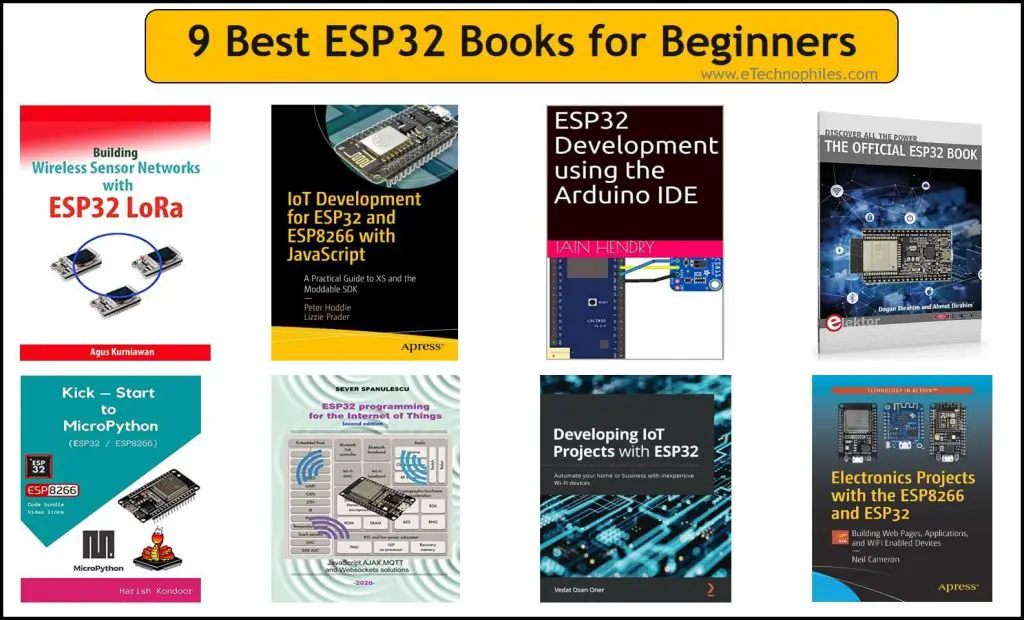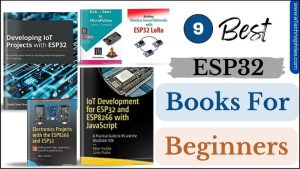Last updated on February 8th, 2025 at 01:30 pm
With the rise in popularity of the ESP32, more enthusiasts are switching to this tiny SoC to build electronic projects. But, the resources to learn about this powerful device are limited. That’s why we have selected the 7 best ESP32 books from a variety of sources that will help you in learning about this device.
These books will teach you everything you need to know about the ESP32 Board, from programming it using Arduino IDE, MicroPython, and JavaScript to hardware interfacing. So without further ado, let’s get started!

List of the 9 Best ESP32 Books
The Official ESP32 Book
The first book on this list is “The Official ESP32 book”. This book is an ideal beginner’s guide to the processor, which covers the major hardware and software functions of this chip. The main goal of the book is to show readers how to use the hardware and software in real-world applications, using the popular ESP32 development board.
The book also contains many basic, and intermediate-level projects that will give you a practical insight into the board. The projects are programmed using the Arduino IDE and MicroPython.
Pros:
- The book covers all topics with proper explanations.
- The projects are organized with an increasing level of difficulty.
Cons:
- Bluetooth is not mentioned in this version of the book because the Arduino IDE library for Bluetooth was unavailable at the time of publication.
ESP32 Programming for the Internet of Things by Sever Spanulescu
“ESP32 Programming for the Internet of Things” is intended to help you get started with your programming career in a very simple manner. The best part of this book is that all the programs discussed here are verified by the students of Hyperion University.
This is one of the best books that teach you how to program the ESP32 so that it can connect to the internet and exchange data with web servers. In addition, you will learn how to use the ESP32’s built-in peripherals to create projects such as a temperature sensor and a WiFi-enabled device controller.
The book also focuses on new solutions, such as the Asynchronous web server library, which is used for bidirectional transfers. With the graphical elements for the IoT web pages, it becomes easy to understand the concepts and achieve a firm grip on the topic.
By the end of this book, you will have gained a solid understanding of how to use it in a variety of IoT applications.
Pros
- A step-by-step guide that will walk you through the fundamentals of more advanced IoT concepts.
- All the examples are explained with schematics and code.
Cons
- Only the Kindle edition is available
- This book is a practical guide. And if want to start with the theory of ESP32 then you must not buy this book.
Developing IoT Projects with ESP32 by Vedat Ozan Oner
This ESP32 book on developing IoT projects will teach you how certain projects need fast delivery to end-users, as well as examples of using a variety of display technologies. A separate chapter about cybersecurity is included in the book, which is jam-packed with hands-on exercises.
It also teaches the skills you need to develop IoT projects using the ESP32 SoC. You’ll learn how to use different types of serial protocols to interface with different sensors and actuators. Additionally, you’ll learn how to securely transmit data between devices and platforms.
Pros:
- Several types of displays are used with ESP32.
- It also covers a chapter where you will learn how to integrate ESP32 with third-party services such as voice assistants and IFTTT.
Cons:
- If you are a complete novice, we don’t recommend this book to you.
Electronics Projects with the ESP8266 and ESP32 by Neil Cameron
”Electronics Projects with the ESP8266 and ESP32” focuses on practical projects, such as Wi-Fi and Bluetooth communication, mobile app design and build, ESP-NOW and LoRa communication, and signal generation.
Most of the projects are programmed using Arduino IDE, so you won’t need to download any additional software. And since mobile apps are now common, the app development projects in this book are very relevant.
You’ll learn how to access information over the internet, develop web pages, build mobile apps that can control devices with speech recognition, or add Google Maps to a GPS route tracking app.
Pros
- Addresses multiple topics ranging from basic electronics projects to building apps.
- Introduction to not only ESP32 but its predecessor also i.e. ESP8266.
Cons
- The reader must have a basic understanding of Arduino IDE and C++.
Kick-Start to MicroPython using ESP32 / ESP8266 by Harish Kondoo
This book offers a wonderful framework and an overview of MicroPython with ESP32 / ESP8266. With less jargon and shorter code snippets, it is very simple to understand and highly recommended to beginners who are yet to explore MicroPython. The examples are also chosen carefully to make things concise and clear. So if you are an absolute beginner, this book is a must.
Pros
- Excellent source for beginners
- The Kindle version is cheap.
Cons
- Not for those who are interested in programming ESP32 using Arduino IDE
ESP32 Development using the Arduino IDE by Iain Hendry
“The ESP32 Development using the Arduino IDE” by Iain Hendry is a comprehensive guide to using the development board using Arduino IDE. The book starts with an introduction to the ESP32 and its features. It then goes on to show how to set up the development environment and get started with programming the board.
The book on ESP32 covers a wide range of topics, including how to control GPIO pins, how to use interrupts, how to work with wireless networks, and how to use built-in sensors. In addition, the book includes a section on troubleshooting and troubleshooting tips. Overall, this is an excellent resource for anyone who wants to get started with developing applications for the ESP32.
Pros
- Teaches you about using the Arduino IDE for development on the ESP32 Board.
- Covers topics such as programming, hardware interfacing, and data storage.
- Cheap
Cons
- Some readers found the book to be a bit too technical.
- There are several important omissions in the book such as which particular ESP32 Board to select under the Tools/Board list.
Building Wireless Sensor Networks with ESP32
This book is a wonderful introduction to the ESP32 LoRa board’s development. It covers the fundamental principles of ESP32 development, including how to create wireless sensor network applications with it. This is a useful book for creating WSN applications with the LoRa.
This book will guide you through important steps right from the start such as preparing the development environment for programming, setting up your LoRa board, data transfer and Interrupts, etc.
Pros
- It has practical circuit examples right from the beginning.
- It covers topics such as programming, hardware interfacing, and data storage.
Cons
- This book does not give an introduction to Wireless Sensor Networks. So this might be challenging for beginners.
IoT Development for ESP32 and ESP8266 with JavaScript by Peter Hoddie
If you use C or C++ environment like Arduino to program ESP32, you can create basic products. However, this won’t let you create the more complex IoT products customers expect today. And this is one of the best ESP32 books that offers a new approach to embedded development, based on current and industry-standard JavaScript.
There are many things that JavaScript does better than other languages. In this book, you will learn how to use JavaScript to create responsive touchscreen user interfaces and communicate over the network. You’ll also learn how to produce IoT products with graphical user interfaces, touch input, networking, BLE, sensors, actuators, and other features.
Pros
- For embedded developers familiar with C or C++, this book has an introduction to the JavaScript programming language.
Cons
- If you have no prior knowledge of programming, this book may seem difficult.
Internet of Things Projects with ESP32 by Agus Kurniawan
“Internet of Things Projects with ESP32” is a collection of fun and instructive projects that explore the capabilities of the ESP32 wifi-and Bluetooth-enabled microcontroller.
Kurniawan leads the reader through each project with clear and concise instructions, providing all the code needed to get started. In addition, he offers helpful tips on troubleshooting and expanding each project.
You will start by learning how to use GPIO to control sensors. Then you will use ESP32 to develop several different IoT projects, such as weather stations, sensor loggers, and smart homes. Finally, you will learn how to use mobile applications and cloud servers with the ESP32.
Whether you’re a beginner or an experienced maker, you’re sure to find something in this book to pique your interest. So power up your soldering iron and dust off your Arduino IDE – it’s time to get making!
Pros
- This is a step-by-step guide that will walk you through the fundamentals of more advanced IoT concepts with ESP32.
- Comprehensive
Cons
- You should have basic knowledge of C or C++.
- The book is out of date, suggesting that you instead use an older version of the software (ESP32-IDF) and a different toolchain.
Best ESP32 Books: Conclusion
These are some of the best books on the ESP32 development board. These books will help you get started with programming and hardware interfacing with the ESP32. If you have no prior knowledge of programming, then some of these books might be challenging for you. But if you are familiar with C or C++, then these books will be a good resource for learning how to develop IoT products with ESP32. Thanks for reading! I hope this was helpful! 🙂
P.S: If you found this article helpful, please share it with your friends and colleagues! Thanks! “
P.P.S: Check out our similar blog post on the best Electronics books for beginners!









